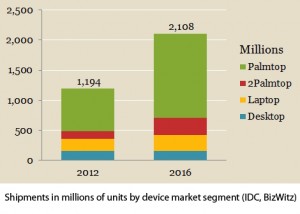Display Makers Must Stay Close to End-Users
 Four recent news stories illustrate why display makers must stay close to end-users.
Four recent news stories illustrate why display makers must stay close to end-users.
- Panasonic may exit the TV business
- Sharp missed Qualcomm’s targets for investment
- CPT is repurchasing the assets it sold to Giantplus
- Samsung advances mobile AMOLED technology to FHD
Nikkei in Japan published unattested reports that Panasonic would exit the TV business entirely over the weekend. Similar rumors have been circulating for some time and several analysts note that the new president of Panasonic earned his way to the top by making tough decisions, such as closing two of its three plasma TV plants in 2011. In January, Panasonic announced the closure of its plant in Shanghai. Earlier this month, projections published by DisplaySearch indicated Panasonic is reducing production of LCD TV panels, also. Panasonic’s panel output was 10.4 million in 2011, but its output in 2013 is expected to be only 4.0 million. The projection for Panasonic LCD TV sets remains flat at 10.5 million in 2012 and 2013, however. Apparently, Panasonic is managing costs by buying panels from other producers.
Looking at financial results from AU Optronics (AUO) and LG Display (LGD) from 2004 through 2012 shows why Panasonic may be smart to buy rather than make TV panels. The chart converts consolidated financial results for both producers into US dollars at year-end and adds those together. Over nine years, their combined free cash flow was minus $871 million. The leading merchant LCD suppliers put more money into the ground than they dredged up with all that hard work. Standing outside the money pit, it makes sense to buy the panels at a discount to full cost rather than dig your own hole.
Over the nine years, the sales price per square inch of LCD decreased 15 percent a year for the two suppliers combined while their EBITDA (profit without depreciation or tax charges) per square inch decreased 23 percent a year. Given the pace of price reduction, even with the improving market for mobile panels, their area cost remains about 7 percent too high for sustaining a profit margin.
Given the commodity pressures on TV prices worldwide, it is unclear how a traditional electronics company makes money in TV, even if it stays close to its distribution channels. We have already seen old-line firms such as Philips divest its TV assets and it seems likely that Panasonic will follow that lead. The market belongs to younger companies in lower-cost regions with less need for financial returns to satisfy Wall Street or The City.
The problem for Sharp is similar but it has less control over product plans and technology objectives beyond its branded TV market. In the past, when Sharp had stronger positions in the gadget market, the company was able to coordinate technology and end-product plans between its panel and gadget businesses. With the rise of Apple and Samsung, Sharp has less control. The panel business is farther from its end users.
Stories about Qualcomm pulling back from its second round of investment in Sharp this week highlight this problem. Apparently, Sharp missed some milestones regarding the metal-oxide TFT work for Pixtronics’ MEM display project. As we saw with delays for metal-oxide LCD last year, perfecting new semiconductor technology is not easy and its harder if the supplier faces external deadlines. This is a difficult period for Sharp as it becomes more dependent on outside investment while its end-user markets are a step beyond Sharp’s customers (e.g., Samsung).
Getting closer to end-users seems to be a good explanation for recent machinations by Chunghwa Picture Tubes (CPT). Back in 2007, CPT announced the sale of its Gen-3 LCD line to Giantplus for cash and stock. That made sense if CPT was able to establish a strong position in large panels while Giantplus supplied small touch screens.
CPT has done better in the small panel business, however. As a result, it is better off in high-touch market segments; so selling its TV module line in Shenzhen to CSOT (a TCL affiliate) and buying its Gen-3 line back makes sense.
Samsung’s introduction of full-HD in the Galaxy S4 illustrates the value of coordination to me. The display business (SDC) was able to use PenTile technology for a mosaic-like pixel pattern that achieves something like 400 ppi resolution. The Samsung group had to change several things in the AMOLED process as well as the overall display-product design to map this new space. That would have been much more difficult and could have been riskier if the display and product businesses had not been affiliates.





